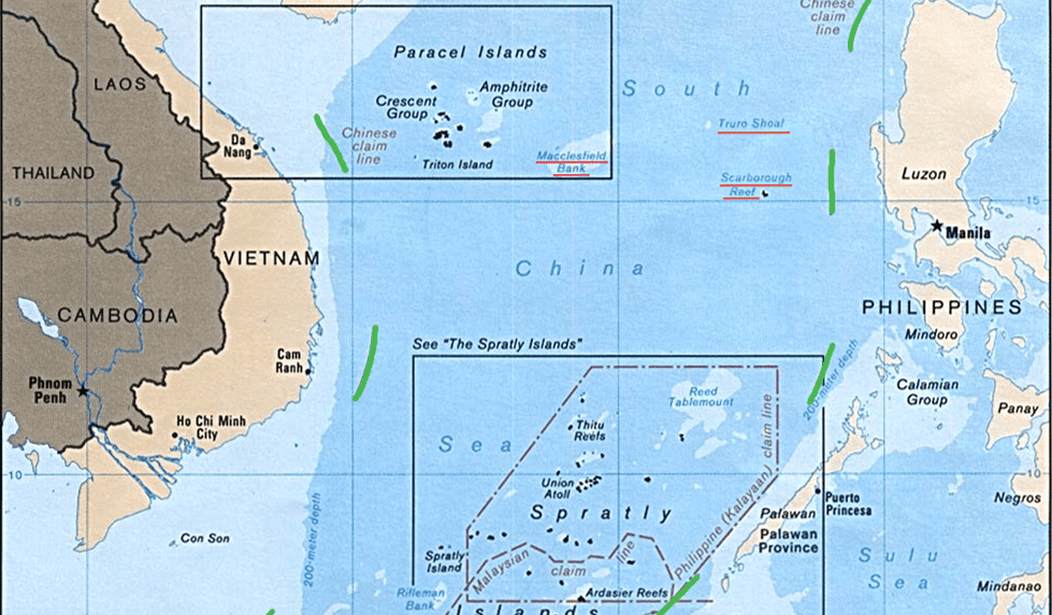More than a century before France built the ill-fated Maginot Line, Napoleon Bonaparte supposedly was presented with a similar fortification plan, and his response (perhaps apocryphal) was, “What are you trying to defend me against, smugglers?” American General George S. Patton is on the record saying, “Fixed fortifications are monuments to man’s stupidity.” More broadly, from the SWAT team preparing to bring in a criminal holed up in a bank, to a bunker-buster bomb crippling the best-engineered underground fortress, if there’s one thing governments know how to do, it’s how to bring overwhelming force down on a known location.
That’s been my line of thinking while most everyone else has been fretting about China’s unprecedented fortification of the South China Sea (SCS) — and now it seems that even Beijing has caught on to their error.
Steven Stashwick reported earlier this week for Foreign Policy that “China’s military buildup on its artificial islands in the South China Sea, appears to be reaching a peak.” Over the last six years, Chinese engineers have dredged up 3,000 acres of new islands in the region, and fortified them with “long-range sensor arrays, port facilities, runways, and reinforced bunkers for fuel and weapons.”
Stashwick continues:
But as conspicuous as the bases’ capacity to project China’s offensive power is how little of that might Beijing has actually deployed there. The Pentagon’s latest report on China’s military notes that no new militarization has been observed since China placed air defense and anti-ship missiles in the Spratlys last year. Gen. Joseph Dunford, the chairman of the U.S. Joint Chiefs of Staff, recently remarked that if China’s militarization of the islands had plateaued, it was because they had achieved the military capability China required of them. If that’s true, then China requires much less of those bases militarily than their apparent potential to deliver.
Imagine if France in the 1930s had poured all the concrete for the Maginot bunkers, then reconsidered and decided to use the steel and effort that would have gone into the big guns and used it instead for tanks and planes and training — which might have done considerably more good against the Nazis.
Maybe Beijing has caught on to a bit of instructive history, which I wrote about here back in May:
In WWII, Japan had a yuge naval fortress on Truk Island, strategically located in the heart of the Pacific. At Truk the Japanese could protect and repair warships, and control the skies with the island’s multiple airstrips. Rather than try to take the island, Admiral Raymond Spruance conceived and commanded Operation Hailstone to neutralize it instead. With nine carriers at his service (five fleet-size, four light), Hailstone was, in essence, a drive-by shooting. Task Force 58’s ships barely paused while 500+ carrier-based planes put the island fortress out of business for the rest of the war. TF58 was too mobile, too fast for the Japanese forces at Truk to do much more than suffer the blows.
These days we wouldn’t send in carrier battle groups, which might be vulnerable to China’s SCS-based missiles, but the land-attack missiles on board two or three stealthy attack subs could put Fort Dredge out of business for a good, long while.
It might also be the case that Beijing has finally noticed the geopolitical costs of its military buildup in the SCS. When Beijing revealed its “nine-dash line,” disregarding international law and claiming almost the entire SCS as its own, let’s just say that the other countries in the area (including Vietnam, the Philippines, Taiwan, and Malaysia) weren’t exactly thrilled. The ongoing dredging and military buildup even forced Philippine President Rodrigo Duterte, a fan of China’s rulers and just as thuggish, back into America’s arms. Well, at least a little bit.
The ongoing fuss, combined with China’s neo-imperialist “Belt and Road Action Plan,” have finally awakened U.S. planners to Beijing’s ambitions.
That’s a pretty big blunder for Chinese President Xi Jinping, who tries to play the patient leader with the longterm vision, but who in reality is in such a hurry to Make China Imperial Again that he’s pissed off and/or scared everyone in China’s neighborhood and the Pentagon.
My only remaining concern about the Fort Dredge is this: Like our hypothetical about France deciding not to fully commit to the Maginot Line, what’s China doing with all the resources those little islands won’t be getting?










Join the conversation as a VIP Member